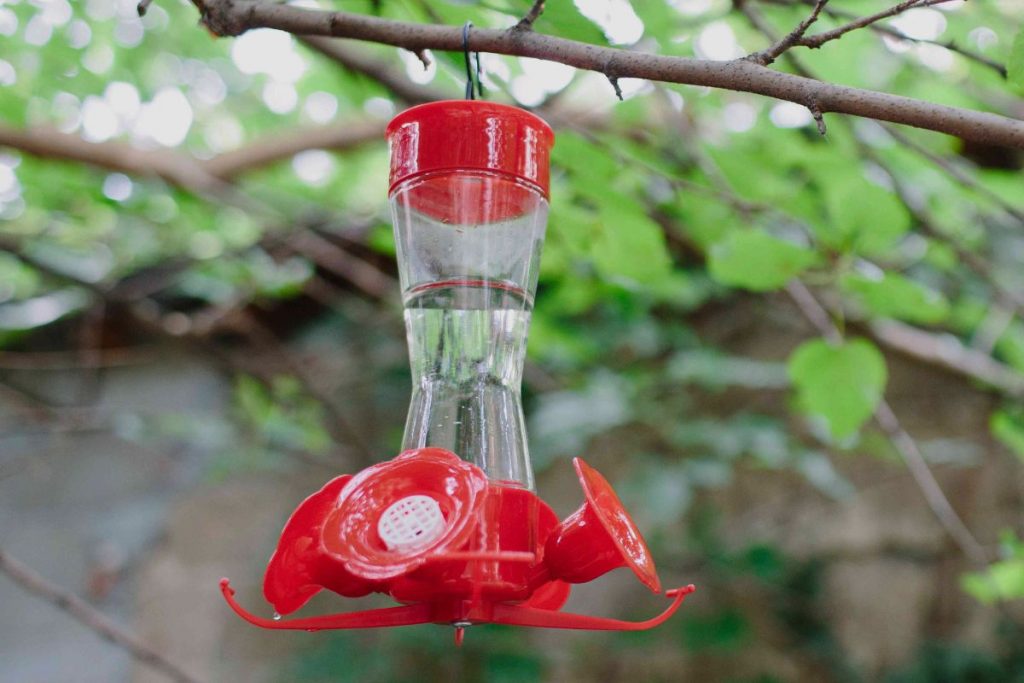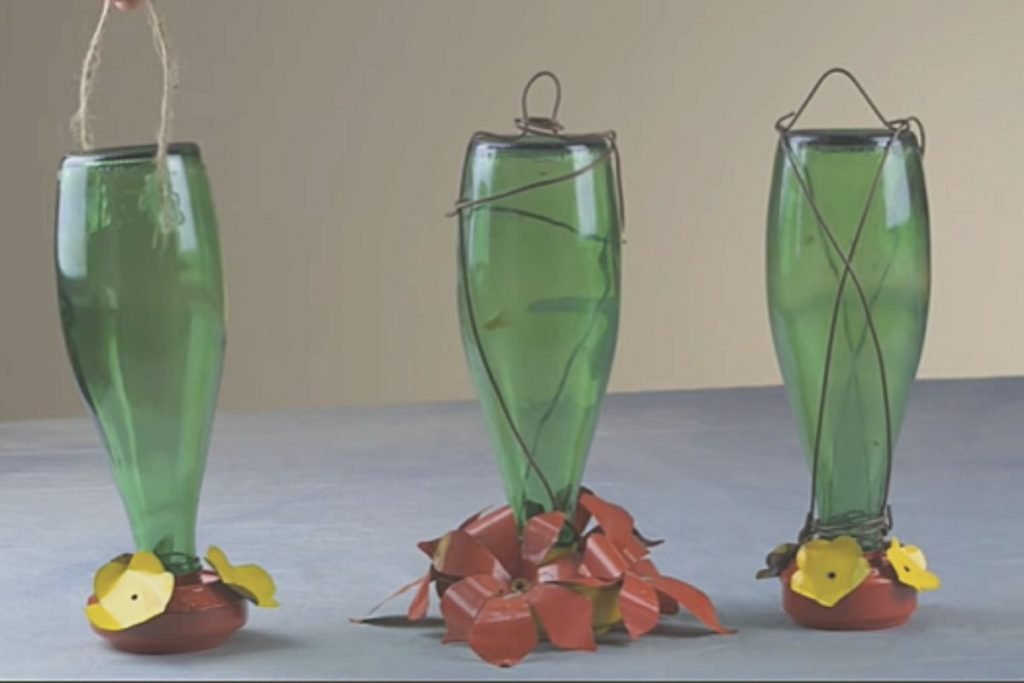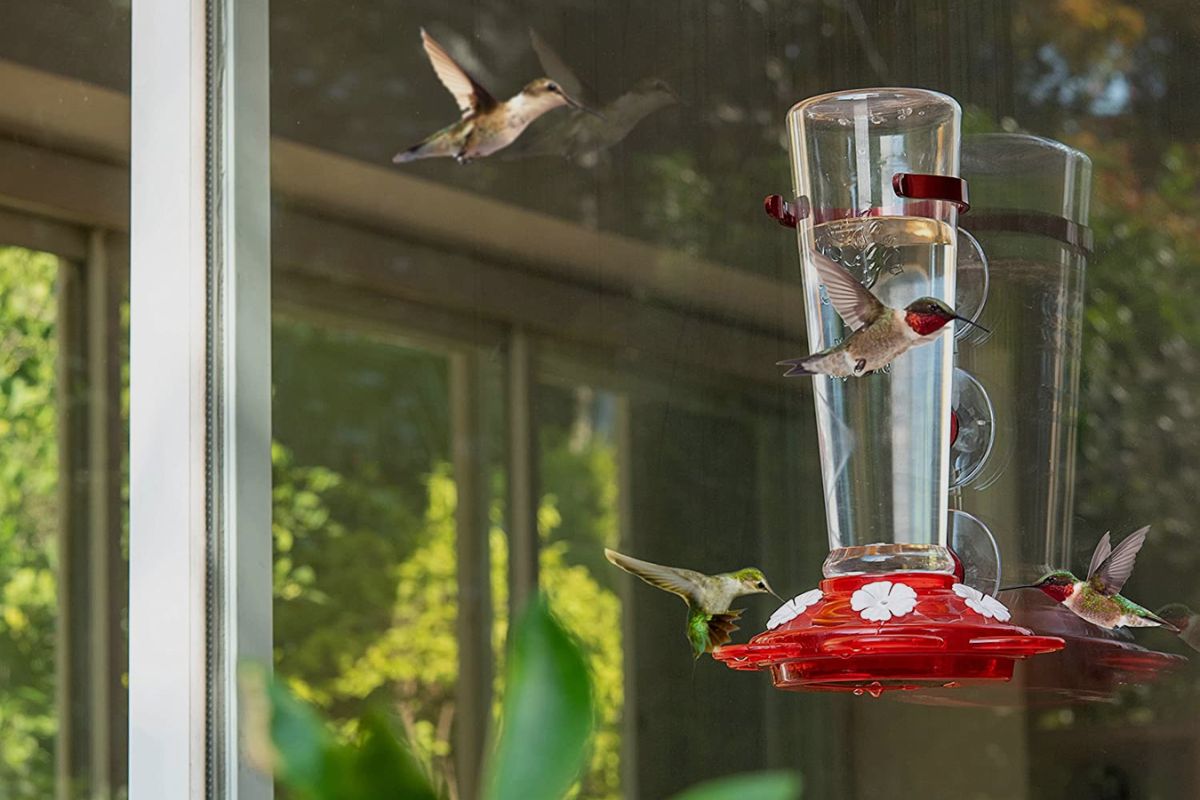As adorable and fascinating as hummingbirds are, it’s essential to consider where you should not hang a hummingbird feeder. A common misconception is that just because hummingbirds are known to flit from flower to flower, they will be equally attracted to feeders in any location.
However, the wrong spot for your feeder could end up deterring these beautiful creatures. You should avoid hanging hummingbird feeders in direct sunlight, high-traffic areas, and places without protection from predators.
In this blog post, we will delve deeper into the specifics of hummingbird feeder placement and why certain locations may not be ideal for these fascinating birds. We’ll explore the impacts of direct sunlight on the feeder, the risks associated with high-traffic areas, and the importance of ensuring safety from predators.
- The Risks of Direct Sunlight
- The Dangers of High-Traffic Areas
- The Importance of Protection from Predators
- Other Considerations
- Conclusion
- FAQs – Where Should You Not Hang A Hummingbird Feeder
- Q: Why should hummingbird feeders not be placed in direct sunlight?
- Q: What risks do high-traffic areas pose for hummingbirds?
- Q: How can we ensure protection from predators for hummingbirds?
- Q: How important is the cleanliness of the hummingbird feeder?
- Q: How can I prevent ants from reaching the hummingbird feeder?
- Q: Should I place the hummingbird feeder near other bird feeders?
- Q: Can I use homemade hummingbird food for the feeder?
- Q: What else can I add to my garden to attract hummingbirds?
- Q: How can I provide shade for my hummingbird feeder?
- Q: What is the ideal location for hanging a hummingbird feeder?
- Q: How can window collisions be prevented?
- Q: How often should I change the nectar in the hummingbird feeder?
- Q: What type of hummingbird feeder is best?
- Q: Can hummingbirds drink from a bird bath?
- Q: Why do hummingbirds need protection from larger birds?
- Q: Is it better to hang hummingbird feeders in a tree or on a feeder pole?
- Q: Can I use shop-bought nectar for my hummingbird feeder?
- Q: Can I hang multiple hummingbird feeders together?
- Q: Why is the fermentation of the nectar in the hummingbird feeder bad?
- Q: How does the type of feeder impact hummingbirds?
- Image Gallery – Where Should You Not Hang A Hummingbird Feeder
Related post to read: Best Hummingbird Feeders.

The Risks of Direct Sunlight
Direct sunlight might seem like an attractive option for your hummingbird feeder since it could glimmer attractively and potentially attract more hummingbirds. However, it’s one of the places where you should not hang a hummingbird feeder.
Direct sunlight causes faster fermentation of the nectar, which can quickly turn the sweet nectar sour. This can be harmful to the hummingbirds and discourage them from visiting your feeder.
Moreover, if your feeder is a glass feeder, direct sunlight could potentially cause it to overheat, posing a risk to the delicate hummingbirds. Instead, opt for a shaded location or a spot that receives partial sunlight. Afternoon shade is particularly beneficial as it keeps the nectar fresh and the feeder cool during the warmer parts of the day.
The Dangers of High-Traffic Areas
While hummingbirds are agile flyers with excellent eyesight, high-traffic areas can pose risks. Hummingbird feeders hung near windows or other high-traffic areas could result in bird collisions. To prevent this, consider window hummingbird feeder placement carefully to minimise the risk of window collisions.
Moreover, hanging your hummingbird feeder near traditional bird feeders that attract seed-feeding wild birds could lead to territorial disputes, especially with larger birds. This could deter your hummingbird visitors and make the feeder a less desirable location.

The Importance of Protection from Predators
Predator safety is crucial in ensuring a safe environment for hummingbirds. Predators, including larger birds and other animals, can pose a significant threat to hummingbirds. That’s why it’s important to hang your hummingbird feeder in a safe location that provides adequate cover.
One good idea is to hang your feeder from a sturdy tree branch in your garden. Nearby covers, such as tree branches and native plants, can offer protection from potential predators. The tree limb could also provide a convenient perch for the hummingbirds as they feed. However, remember to balance between providing a safe, shaded spot and avoiding too much cover that could inhibit the birds’ accessibility to the feeder.
Other Considerations
The type of feeder and the homemade hummingbird food you provide can also impact the success of your hummingbird garden. Keeping your feeders clean and ensuring a fresh supply of sugar water or shop-bought nectar can help keep your hummers healthier. Also, consider the use of an ant moat to prevent ants and other insects from reaching the nectar.
Further, consider adding a bird bath or garden pond to your outdoor space as a water source for the birds. It will not only attract more hummingbirds but also provide a way to keep them cool and hydrated during the warmer months.
Conclusion
When planning the placement of your hummingbird feeders, keep in mind that the ideal spot is not just about where the birds can see the feeder but also where they will feel safe and comfortable. Avoid direct sunlight, high-traffic areas, and places with no protection from predators.
Always strive to create a sanctuary that these amazing creatures will love to return to time and again.
Remember, the joy in attracting hummingbirds is not just in the number of visits but also in the assurance that you are providing a safe and friendly environment for these wondrous creatures to thrive. Can you think of anything more rewarding than creating a safe haven for these fascinating birds in your own backyard?
FAQs – Where Should You Not Hang A Hummingbird Feeder
Q: Why should hummingbird feeders not be placed in direct sunlight?
A: Hanging hummingbird feeders in direct sunlight can lead to faster fermentation of the nectar, which could turn it sour and harmful for the birds. Also, if your feeder is made of glass, it could potentially overheat in the sun, posing a risk to the delicate hummingbirds.
Q: What risks do high-traffic areas pose for hummingbirds?
A: High-traffic areas such as busy paths or near windows can lead to bird collisions, causing harm to the hummingbirds. They could also discourage them due to the excessive noise and movement.
Q: How can we ensure protection from predators for hummingbirds?
A: Hanging the feeder in a location that provides adequate cover, like a sturdy tree branch, can offer protection from potential predators. The balance is crucial, though, as too much cover can restrict accessibility to the feeder.
Q: How important is the cleanliness of the hummingbird feeder?
A: Cleanliness is extremely important. Dirty feeders can harbour bacteria and mould that can harm the birds. Regular cleaning and refilling with fresh nectar can help keep the birds healthy.
Q: How can I prevent ants from reaching the hummingbird feeder?
A: An ant moat is a useful tool that can be added to the hummingbird feeder to prevent ants and other insects from reaching the nectar.
Q: Should I place the hummingbird feeder near other bird feeders?
A: It’s advisable to avoid hanging your hummingbird feeder near traditional bird feeders that attract larger, seed-feeding birds. This can lead to territorial disputes and could deter your hummingbird visitors.
Q: Can I use homemade hummingbird food for the feeder?
A: Yes, homemade hummingbird food, typically a sugar water solution, can be used. However, it’s crucial to get the proportions right to ensure the food is safe and healthy for the birds.
Q: What else can I add to my garden to attract hummingbirds?
A: Adding a bird bath or garden pond can help attract more hummingbirds by providing a water source. Also, planting native flowers and plants that hummingbirds naturally feed on can make your garden more attractive to them.
Q: How can I provide shade for my hummingbird feeder?
A: You can hang your hummingbird feeder in a location that naturally provides shade, such as under a tree or a garden bench. A spot that gets afternoon shade would be ideal.
Q: What is the ideal location for hanging a hummingbird feeder?
A: The ideal location is a safe and accessible location that provides partial sunlight, safety from predators, and is away from high-traffic areas.
Q: How can window collisions be prevented?
A: Careful placement of window hummingbird feeders can minimise the risk of window collisions. You can place feeders either very close (within 3 feet) or quite far (over 10 feet) from the window to reduce collisions.
Q: How often should I change the nectar in the hummingbird feeder?
A: During warmer months, it’s best to change the nectar every two to three days. In cooler temperatures, once a week should suffice.
Q: What type of hummingbird feeder is best?
A: The best hummingbird feeder is one that is easy to clean, has ant and bee guards, and is brightly coloured (usually red) to attract the birds.
Q: Can hummingbirds drink from a bird bath?
A: Yes, hummingbirds can and do drink from bird baths, especially ones with shallow edges. They also enjoy bathing in them.
Q: Why do hummingbirds need protection from larger birds?
A: Larger birds can be territorial and may attempt to monopolise the feeder, preventing the smaller hummingbirds from feeding.
Q: Is it better to hang hummingbird feeders in a tree or on a feeder pole?
A: Both options can work well, provided they offer a safe, quiet location with some shade and protection from predators.
Q: Can I use shop-bought nectar for my hummingbird feeder?
A: Yes, you can use shop-bought nectar, but make sure it’s free from additives and dyes, which can be harmful to the birds.
Q: Can I hang multiple hummingbird feeders together?
A: It’s best to space out your hummingbird feeders to prevent territorial behaviour and to attract a variety of hummingbirds to your garden.
Q: Why is the fermentation of the nectar in the hummingbird feeder bad?
A: Fermented nectar can be harmful to hummingbirds. It can cause them to become sick and discourage them from returning to the feeder.
Q: How does the type of feeder impact hummingbirds?
A: The type of feeder can impact the ease of access to food for the hummingbirds and how comfortable they are while feeding. Certain feeder designs are more hummingbird-friendly than others.
Image Gallery – Where Should You Not Hang A Hummingbird Feeder



Other related posts to read:
- How High Should Hummingbird Feeder Be?
- Does Hummingbird Feeder Have To Be Red?
- How To Remove Rust From Hummingbird Feeder.
References:
- About Hummingbird (Wikipedia).
- About Bird Feeder (Wikipedia)
- Greenewalt, C. H. (1960). Hummingbirds. New York: Doubleday. Google Scholar.
